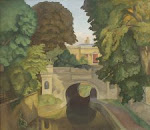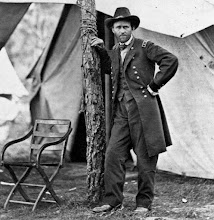Poetry helps us to pay closer attention to the World around us.
By "the World," I mean anything out there that we can see, hear, smell, touch, or taste.
The World does not -- I repeat: does not -- include any of the following: politics, popular entertainment, the media, sociology, psychology, and the scientific method. These are, at best, distractions. Most often, they are pernicious deceptions.
I claim absolutely no originality with respect to these observations. We all know these things. But the distractions and deceptions that surround us are seductive and powerful. Thus, for instance, it is highly likely that, this very evening, I will sit down in front of the television and watch an episode of "The World's Dumbest Criminals," "American Pickers," or "Ice Road Truckers." (I apologize to all of my non-American readers for those arcane references.)
Poetry helps us to pay closer attention to the World around us. If we let it.
Frederick William Hayes, "Rocks in the Colwyn" (c. 1881)
Palmistry
I lifted from the ground my grass-pressed hand
And pondered, as its strange new lines I scanned,
What is foretold? What hope, what fear,
What strife, what passion is prefigured here?
Andrew Young, Winter Harvest (1933).
Frederick William Hayes, "The Rivals from Llanddwyn" (c. 1884)
When all the reeds are swaying in the wind
How can you tell which reeds the otters bend?
Michael Longley, Selected Poems (Jonathan Cape 1998).
Frederick William Hayes, "A Waterfall" (c. 1880)
Wednesday, September 19, 2012
Subscribe to:
Post Comments (Atom)






6 comments:
Stephen,
I'm not sure this is relevant, but I read or heard somewhere that the hand is one of the most common elements found in pictographs and cave paintings around the world.
I know I've seen the hand in pictures and documentaries of cave paintings in France and Australia and I've seen it in pictographs here in the Southwestern US.
I wonder what it meant to the artist. Could it have been a signature--a sign that "I" was here?
Dear Stephen,
Thank you very much for your recent posts of poems by Andrew Young. I dare say he is my favourite poet. I cannot claim a great experience in poetry but Young's deceptive simplicity spoke to me immediately when I discovered him a decade ago.
Perhaps you would like to visit my website which I dedicated to Young.(However, I have to apologize for the nauseating pop-ups.)
Fred: thank you for bringing that up. I hadn't thought of that in connection with the poem. I went through a period (back when I was spending time in the Four Corners area, and points north and south of there) when I did a lot of reading about, and looking at, Anasazi pictographs and petroglyphs. The images of hands are very beautiful and haunting.
Thanks for the thoughts.
Mathias: thank you very much for mentioning your website. Actually, I discovered it on my own a couple of years ago! I am delighted to find out that it is your creation.
I was pleased to see your essay on the connections between Young's poetry and Paul Nash's art. As you know from your visits here, I am very fond of Nash's art (as well as that of his brother). The connections that you make between Young's work and Nash's work are very interesting.
On a different artistic point: I'm sure that you have a copy of Young's Collected Poems with the lovely wood engravings by Joan Hassall -- the poems and engravings work wonderfully together, I think.
Again, it is a pleasure to discover that the website is yours. I thank you for doing such a great service to Young: he deserves more recognition, and you are helping to bring that about.
I've posted some reactions to this on my own blog:
http://corkyagain.blogspot.com/2012/09/send-chaperones-away.html
Enjoying yours very much!
CorkyAgain: thank you very much for your kind words, and for mentioning my post in your blog. You are right: my observations definitely apply to music and art as well -- and to all good "art" in general. All of these ask us to pay closer attention to what is going on around us.
I agree: the Hiroshige woodblock print does strike a chord for those of us who live in a rainy world!
Thanks again.
Post a Comment